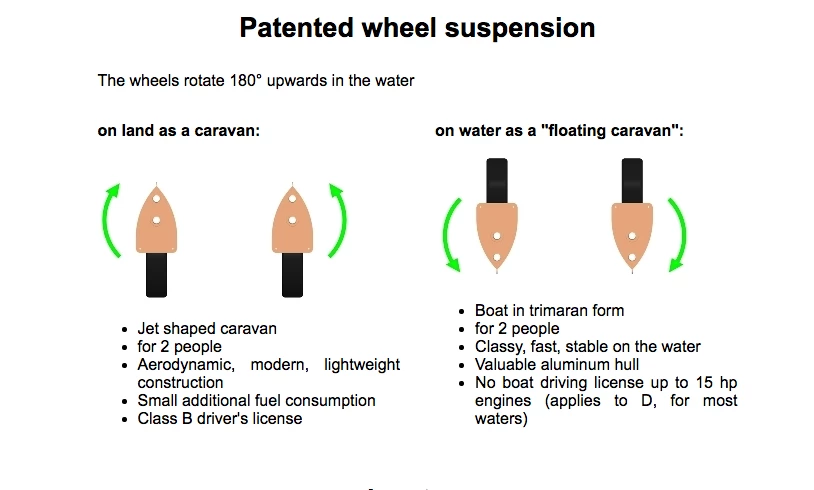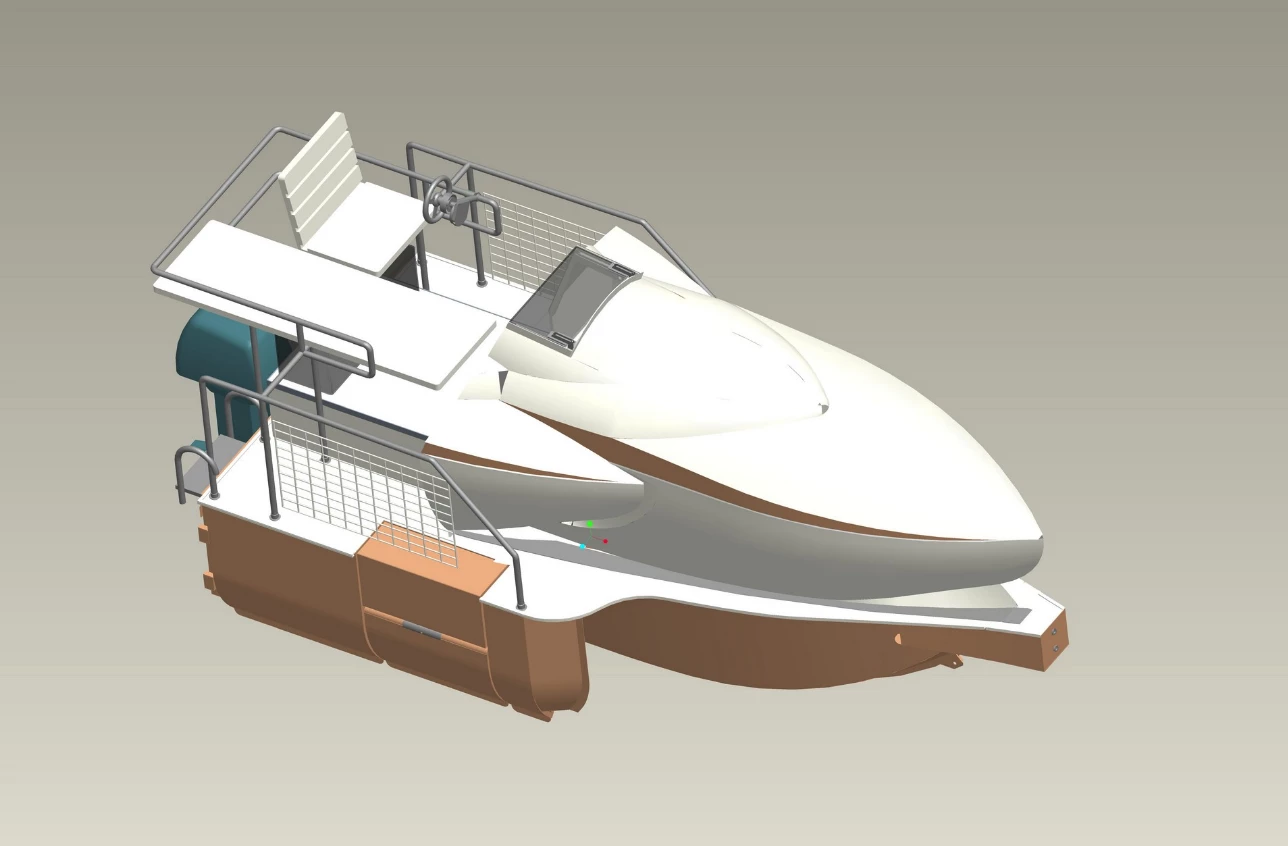Normally we'd be quite satisfied to see one all-new multi-hull camper boat at any given event, but this year's Düsseldorf Caravan Salon had two, each demonstrating a unique take on the idea of buoyant RVing. The soon-to-launch Scoter wasn't as large or pretty as the Caracat that stared it down from across the outdoor courtyard between exhibition halls, but it boasted a slick feature the Caracat did not. The trimaran camper's integrated wheels rotate 180 degrees back into the hulls, eliminating the need for a separate boat trailer, while delivering smooth, stable flotation on the water.
The Scoter was the biggest WTF moment of our weeklong trip to this year's Caravan Salon. The drably colored vessel was just kind of planted outside one of the exhibition halls, with no other exhibits directly near it. It looked like someone towed it there in the middle of the night and left it in the hope no one would remove it by the next morning. No one ever did, as far as we saw. The vessel was also the only completely unstaffed display we saw at the show, with little more than two roughly cobbled signs – one German, one English – identifying it with simple print on basic white paper.

Just as odd was the note, hastily attached via yellow painter's tape, which read, "This caravan can be towed by car. Exceptionally for this fair it is placed on a trailer." So the trailer's one real claim to fame was nearly obscured entirely. We assumed (since there was no one to ask) the trailer was there to better stabilize the vessel in the absence of the g̶e̶t̶a̶w̶a̶y̶... tow vehicle. It was easy enough to pick out the Scoter tires resting atop the trailer bed once you knew to look for them.
All that said, the Scoter was one of the cooler concepts out in the open Rheinland air, if not the prettiest or most immediately enticing. Other sizable multi-hull boat campers we've covered rely on a separate boat trailer for transport. The self-reliant Scoter rolls behind the tow vehicle on its own wheels, and when it gets in the water, the captain can flip those wheels up to store them away in the side hulls. The cladding above each flips down and fits into the greater hull like the last puzzle piece, ensuring smoother on-water movement without the drag of two wheels dunked below the surface. It's essentially the same idea as an aircraft's retractable landing gear, just in a much simpler form.

We've seen other amphibious camping trailers with built-in wheels, including the German-developed Sealander, but those wheels are fixed and don't retract away. We're not sure how much of a noticeable difference that will make on a slow-cruising water camper, but if it's an electric motor doing the work, any decrease in drag and increase in efficiency can only help prolong the finite battery autonomy.
One of the reasons the Scoter looks a little rough and odd is that the two side hulls are more like tall, stubby half-length sponsons than they are long, sleek hulls common on trimarans. From some angles, it appears almost like the designers simply slapped them onto a small aluminum monohull boat. The craft isn't designed to race the sea, though, but to drift leisurely under the power of a small electric or fuel motor. The German startup says it is designed to handle up to 60 hp but advises that motor output of 15 hp or less means not having to get a boat license for use in many waters.
The Scoter model in Dusseldorf was all gated off – or at least painter-taped off – and inaccessible for boarding. The company describes a two-person camper interior complete with a galley and a standing-height wet bathroom with toilet and shower. The two occupants will find sun lounge space on the small deck around the simple helm station. The company is still finishing the interior fit-out and plans to publish photos soon.

The Scoter measures 4.8 m (15.7 ft) in total length and has a waterline length of 4 m (13 ft). It's 2.2 m (7.2 ft) wide with an on-road height of 2.5 m (8.2 ft). Base weight checks in at 720 kg (1,587 lb) and leaves a 300-kg (660 lb) on-road payload, meaning it can be towed under a regular Category B driver's license.
We feel like the Scoter crew would be better off nipping and tucking the design through a series of prototypes to create something more polished and marketable, but they are planning to go right into production in (Northern Hemisphere) fall 2023 ... which is nearly here. Prices start at €18,200 (approx. US$18,200), a fraction the price of a larger land/water multi-hull camper like the Caracat and also well less than the tiny Sealander teardrop that's now priced at €26,495. Buyers who prefer a conventional boat can also order the Scoter without wheels.

Hopefully, the Scoter folks at least add a few more color options in the coming weeks, if they do in fact stick to the autumn production launch. They do admit that the prototype exhibited in Düsseldorf was beaten and battered from testing, so presumably a fresh-out-the-factory model will look better, even if only a little. Tow and float it into an alpine lake backdrop, however, and camper-captains will soon forget all about those lackluster looks.
Source: Scoter









